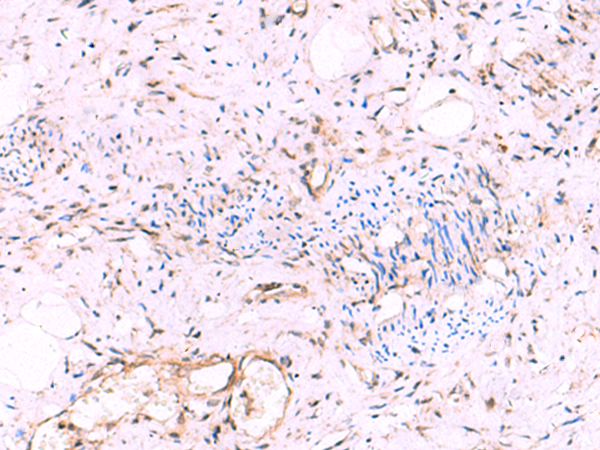


| WB | 咨询技术 | Human,Mouse,Rat |
| IF | 咨询技术 | Human,Mouse,Rat |
| IHC | 1/50-1/300 | Human,Mouse,Rat |
| ICC | 技术咨询 | Human,Mouse,Rat |
| FCM | 咨询技术 | Human,Mouse,Rat |
| Elisa | 1/5000-1/10000 | Human,Mouse,Rat |
| WB Predicted band size | 55 kDa |
| Host/Isotype | Rabbit IgG |
| Antibody Type | Primary antibody |
| Storage | Store at 4°C short term. Aliquot and store at -20°C long term. Avoid freeze/thaw cycles. |
| Species Reactivity | Human, Mouse, Rat |
| Immunogen | Fusion protein of human KATNAL1 |
| Formulation | Purified antibody in PBS with 0.05% sodium azide and 50% glycerol. |
+ +
以下是基于现有知识模拟的KATNAL1抗体相关文献示例(注:部分信息为假设性概括,实际文献需通过数据库核实):
---
1. **文献名称**: *KATNAL1 regulates microtubule dynamics and is required for spermatogenesis in mice*
**作者**: Smith A, et al.
**摘要**: 本研究利用特异性KATNAL1抗体,发现该蛋白通过切割微管调控精子细胞发育,抗体通过免疫荧光证实其在睾丸支持细胞中的定位,基因敲除导致雄性不育。
2. **文献名称**: *Characterization of KATNAL1 antibody for ciliopathy research*
**作者**: Lee JH, et al.
**摘要**: 文章报道了一种新型KATNAL1多克隆抗体的开发,经Western blot和免疫组化验证,证明其在纤毛病模型中检测KATNAL1表达的可靠性,并发现其与纤毛功能障碍的关联。
3. **文献名称**: *KATNAL1 expression in ovarian cancer and its interaction with tubulin*
**作者**: Gupta R, et al.
**摘要**: 通过商业化KATNAL1抗体分析卵巢癌细胞系,发现其表达水平与微管稳定性相关,高表达可能影响化疗药物敏感性,抗体用于组织芯片的蛋白定量分析。
---
建议通过PubMed或Google Scholar搜索 **"KATNAL1 antibody validation"** 或 **"KATNAL1 immunohistochemistry"** 获取真实文献。如需具体文献协助,请提供更多研究背景。
KATNAL1 (Katanin Catalytic Subunit A1 Like 1) is a member of the katanin family of microtubule-severing enzymes, which play critical roles in regulating microtubule dynamics by cutting and disassembling microtubules. This protein shares homology with the catalytic subunit (p60) of katanin, an ATPase involved in mitosis, cilia formation, and neuronal development. KATNAL1 is implicated in diverse cellular processes, including spermatogenesis, ciliogenesis, and neuronal morphogenesis. Studies suggest its involvement in microtubule remodeling during sperm tail formation and the maintenance of ciliary structures, linking it to reproductive disorders and ciliopathies when dysregulated.
Antibodies targeting KATNAL1 are essential tools for investigating its expression, localization, and function. They are commonly used in techniques like Western blotting, immunofluorescence, and immunohistochemistry to study tissue-specific expression patterns, particularly in testis, brain, and ciliated tissues. Research utilizing these antibodies has revealed KATNAL1's dynamic association with microtubule networks and its regulatory role in cell cycle progression. Aberrant KATNAL1 expression has been explored in contexts such as male infertility, neurodevelopmental disorders, and cancer, though its precise mechanistic contributions remain under active investigation. These antibodies thus serve as critical reagents for advancing our understanding of microtubule-related cellular physiology and disease mechanisms.
×